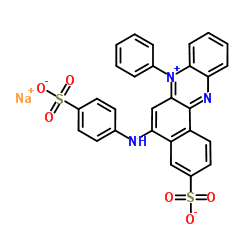Nonspecific ("pseudo-plasmal") dye-binding in the Feulgen nuclear stain and its blocking by azocarmin G.
T Takamatsu, K Nakanishi, Z Onouchi, M Fukuda, S Fujita
Index: Histochemistry 66(2) , 169-80, (1980)
Full Text: HTML
Abstract
In Feulgen nuclear staining nonspecific dye-binding due to the "pseudo-plasmal reaction" is intensified in isolated cells with intact cytoplasm, and cannot be eliminated by the post-irradiation method. Fluorescence intensity in the cytoplasm sometimes exceeds that of specific nuclear fluorescence, especially in brain and heart muscle cells, and it was almost impossible to perform cytofluorometric DNA quantification on such specimens. Various kinds of aldehyde-blocking agents such as sodium borohydride, 2,4-dinitrophenylhydrazine, aniline, and sodium pyrosulfite were effective in reducing the "pseudo-plasmal reaction". But the blocking effects were not complete because of additional release of reactive aldehyde groups during subsequent Feulgen hydrolysis. Acidic azocarmin G produced a complete block of all "pseudo-plasmal reaction" in acriflavine-Feulgen nuclear staining, allowing accurate DNA-cytofluorometry to be carried out.
Related Compounds
| Structure | Name/CAS No. | Molecular Formula | Articles |
|---|---|---|---|
 |
AZOCARMINE G
CAS:25641-18-3 |
C28H18N3NaO6S2 |
|
A novel bacterial pathogen of Biomphalaria glabrata: a poten...
2015-02-01 [PLoS Negl. Trop. Dis. 9(2) , e0003489, (2015)] |
|
Cytofluorometry on cells isolated from paraffin sections aft...
1981-01-01 [Histochemistry 71(2) , 161-70, (1981)] |
|
The structure of the bilaminar zone in the human temporomand...
2001-02-01 [J. Oral Rehabil. 28(2) , 113-9, (2001)] |
|
Histochemical and morphological studies on Trichinella spira...
1994-05-01 [Int. J. Parasitol. 24(3) , 425-7, (1994)] |
|
Dark and light neurons in the human brain, with special refe...
1997-08-01 [Arch. Histol. Cytol. 60(3) , 265-74, (1997)] |